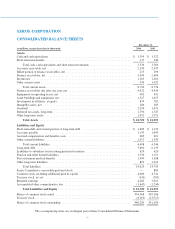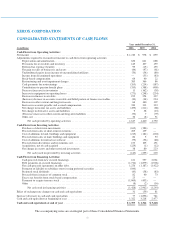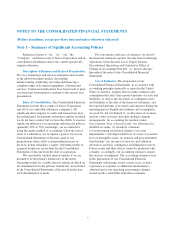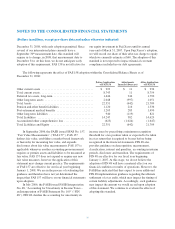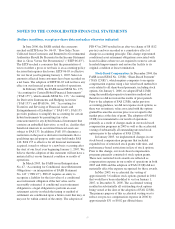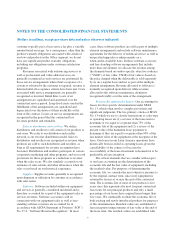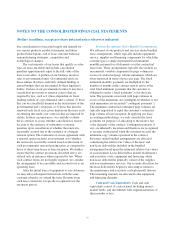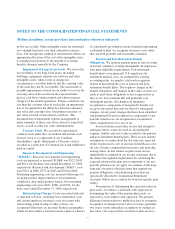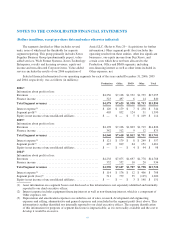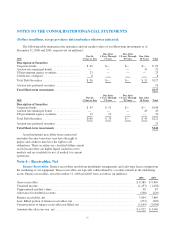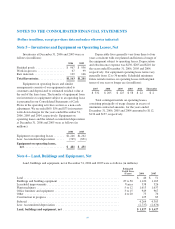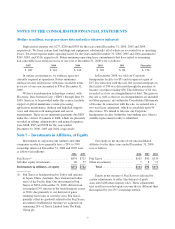Xerox 2006 Annual Report Download - page 63
Download and view the complete annual report
Please find page 63 of the 2006 Xerox annual report below. You can navigate through the pages in the report by either clicking on the pages listed below, or by using the keyword search tool below to find specific information within the annual report.
NOTES TO THE CONSOLIDATED FINANCIAL STATEMENTS
(Dollars in millions, except per-share data and unless otherwise indicated)
Restricted Cash and Investments: Several of our
secured financing arrangements and derivative contracts,
as well as other material contracts, require us to post cash
collateral or maintain minimum cash balances in escrow.
These cash amounts are reported in our Consolidated
Balance Sheets, depending on when the cash will be
contractually released. At December 31, 2006 and 2005,
such restricted cash amounts were as follows (in millions):
December 31,
2006 2005
Escrow and cash collections related to
secured borrowing arrangements ...... $214 $254
Collateral related to risk management
arrangements ..................... 13 43
Other restricted cash ................. 199 149
Total ......................... $426 $446
Of these amounts, $236 and $270 were included in
Other current assets and $190 and $176 were included in
Other long-term assets, as of December 31, 2006 and
2005, respectively.
Provisions for Losses on Uncollectible
Receivables: The provisions for losses on uncollectible
trade and finance receivables are determined principally
on the basis of past collection experience applied to
ongoing evaluations of our receivables and evaluations of
the default risks of repayment. Allowances for doubtful
accounts on accounts receivable balances were $116 and
$136, as of December 31, 2006 and 2005, respectively.
Allowances for doubtful accounts on finance receivables
were $198 and $229 at December 31, 2006 and 2005,
respectively.
Inventories: Inventories are carried at the lower of
average cost or market. Inventories also include
equipment that is returned at the end of the lease term.
Returned equipment is recorded at the lower of
remaining net book value or salvage value. Salvage value
consists of the estimated market value (generally
determined based on replacement cost) of the salvageable
component parts, which are expected to be used in the
remanufacturing process. We regularly review inventory
quantities and record a provision for excess and/or
obsolete inventory based primarily on our estimated
forecast of product demand, production requirements and
servicing commitments. Several factors may influence
the realizability of our inventories, including our decision
to exit a product line, technological changes and new
product development. The provision for excess and/or
obsolete raw materials and equipment inventories is
based primarily on near term forecasts of product
demand and include consideration of new product
introductions as well as changes in remanufacturing
strategies. The provision for excess and/or obsolete
service parts inventory is based primarily on projected
servicing requirements over the life of the related
equipment populations.
Land, Buildings and Equipment and Equipment
on Operating Leases: Land, buildings and equipment
are recorded at cost. Buildings and equipment are
depreciated over their estimated useful lives. Leasehold
improvements are depreciated over the shorter of the
lease term or the estimated useful life. Equipment on
operating leases is depreciated to estimated residual value
over the lease term. Depreciation is computed using the
straight-line method. Significant improvements are
capitalized and maintenance and repairs are expensed.
Refer to Note 5 – Inventories and Equipment on
Operating Leases, Net and Note 6 – Land, Buildings and
Equipment, Net for further discussion.
Goodwill and Other Intangible Assets: Goodwill
is tested for impairment annually or more frequently if an
event or circumstance indicates that an impairment loss
may have been incurred. Application of the goodwill
impairment test requires judgment, including the
identification of reporting units, assignment of assets and
liabilities to reporting units, assignment of goodwill to
reporting units, and determination of the fair value of
each reporting unit. We estimate the fair value of each
reporting unit using a discounted cash flow methodology.
This requires us to use significant judgment including
estimation of future cash flows, which is dependent on
internal forecasts, estimation of the long-term rate of
growth for our business, the useful life over which cash
flows will occur, determination of our weighted average
cost of capital, and relevant market data.
Other intangible assets primarily consist of assets
obtained in connection with business acquisitions,
including installed customer base and distribution
network relationships, patents on existing technology and
trademarks. We apply an impairment evaluation
whenever events or changes in business circumstances
indicate that the carry value of our intangible assets may
61


